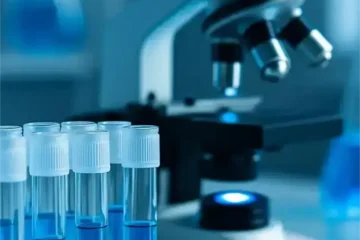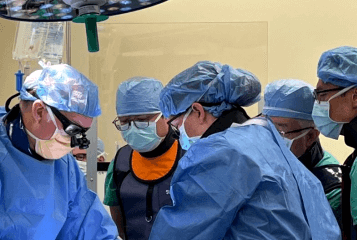Thérapie par cellules souches dans l’autisme : Mécanismes moléculaires, restauration neuronale et intégration comportementaleIntroduction
Le trouble du spectre de l’autisme (TSA) est une affection neurodéveloppementale complexe, caractérisée par des déficits dans la communication sociale, des comportements répétitifs et une variabilité sensorielle. Malgré des décennies de recherche, les thérapies conventionnelles se concentrent principalement sur la gestion des symptômes plutôt que sur la correction des anomalies اقرأ المزيد
List of diseases for which stem cell treatment is most effective
Disease Dose (M cells/kg) Key Improvements Osteoarthritis 0.5 Pain reduction, improved joint mobility, decreased inflammation Rheumatoid Arthritis 0.7 Reduction of joint swelling, pain relief, improved flexibility Ankylosing Spondylitis 0.7 Improved spinal mobility, reduced back pain, decreased fatigue Psoriatic Arthritis 0.6 Reduced joint inflammation, improvement of skin condition, pain reduction Systemic اقرأ المزيد
Crohn’s Disease and Ulcerative Colitis stem cell therapy
6. Crohn’s Disease Intravenous infusion of autologous MSCs has demonstrated significant efficacy in managing Crohn’s disease by reducing abdominal pain, improving bowel function, and reducing inflammation. MSCs modulate immune responses by suppressing pro-inflammatory cytokines, enhancing regulatory T-cell activity, and promoting mucosal healing. The paracrine signaling of MSCs stimulates epithelial regeneration اقرأ المزيد
تصلب متعدد,Parkinson’s Disease,Amyotrophic Lateral Sclerosis (ALS),Alzheimer’s Disease and other – stem cell therapy effects and costs
Multiple Sclerosis In multiple sclerosis, intravenous infusion of autologous MSCs has been shown to reduce muscle spasticity, improve walking ability, and alleviate fatigue. The cells exert their effects by promoting neuroprotection through the secretion of neurotrophic factors, reducing inflammatory demyelination, and modulating the immune system to reduce autoimmunity. MSCs have اقرأ المزيد
Erectile Dysfunction, Sickle Cell Anemia, Osteoporosis,Age-Related Macular Degeneration,Type 2 السكري,Pulmonary Hypertension and other diseases stem cell ethrapy – effects, results and costs
Sickle Cell Anemia MSC therapy for sickle cell anemia has shown potential in reducing episodes of pain, improving red blood cell function, and decreasing anemia-related fatigue. MSCs work by secreting growth factors that support the regeneration of blood cells and enhance bone marrow function. They also help reduce inflammation and اقرأ المزيد
Kidney Failure, Rheumatoid Arthritis,Lupus (Systemic Lupus Erythematosus),Psoriasis,Crohn’s Disease,Hepatitis B,Fatty Liver Disease,Cirrhisis and other diseases stem cell therapy – effects and costs
Rheumatoid Arthritis MSC therapy has shown promise in improving joint mobility, reducing pain, and decreasing inflammation in patients with rheumatoid arthritis. MSCs exert their effects by modulating the immune system, particularly by reducing the activity of pro-inflammatory T cells and cytokines. MSCs also promote tissue repair by stimulating the regeneration اقرأ المزيد
Duchenne muscular dystrophy,Heart Failure,Parkinson’s Disease,Chronic Fatigue Syndrome,Post-Traumatic Stress Disorder,Fibromyalgia,Schizophrenia,Autism Spectrum Disorder,Depression and other disease stem cell therapy – effects and costs
Myocardial Infarction (Heart Attack) MSC therapy for myocardial infarction has shown potential in improving heart function, reducing scar tissue, and enhancing tissue regeneration in the heart. MSCs work by secreting growth factors that stimulate the regeneration of heart muscle cells (cardiomyocytes) and reduce inflammation. They also promote angiogenesis (formation of اقرأ المزيد
Osteoporosis, Muscular Dystrophy, Asthma,Hypertension (High Blood Pressure),Peripheral Artery Disease,Arthritis and other disease stem cell therapy – effects and costs
Muscular Dystrophy MSC therapy has shown potential in improving muscle strength, increasing mobility, and reducing muscle wasting in patients with various forms of muscular dystrophy. MSCs work by promoting the regeneration of muscle fibers, stimulating the production of muscle precursor cells, and reducing fibrosis. They secrete growth factors that enhance اقرأ المزيد
Biomimetic Film Coatings for Aircraft Inspired by Shark Skin: A Breakthrough in Fuel Efficiency Enhancement
Abstract:The aviation industry is undergoing a transformative shift toward sustainable operations, with fuel efficiency being a critical focus. This paper presents the development of a novel film-based surface coating for aircraft, inspired by the microstructure of shark skin. The biomimetic design, characterized by overlapping micro-scale riblets akin to dermal denticles, اقرأ المزيد
Reputational Risk and Market Performance: The Impact of Executive Scandals on Tesla’s Sales in Europe
Abstract:This study explores the correlation between corporate executive controversies and market performance, using Tesla Inc. as a case study. In early 2025, Tesla’s sales in several European markets experienced a significant decline, coinciding with a series of public controversies surrounding its CEO, Elon Musk. By examining sales data, consumer sentiment اقرأ المزيد
Professor Viktor Hryhorovych Lizohub: Life, Teaching, and Scientific Contributions
Early Life and Education Viktor Hryhorovych Lizohub was born on October 12, 1947, in the village of Trebukhiv, Brovary district, Kyiv region, Ukraine. He graduated from the Kyiv Medical Institute named after O.O. Bohomolets in 1972. In 1974, he completed a clinical residency in neurology at the Institute of Gerontology اقرأ المزيد
Potential Benefits of Intravenous Embryonic Stem Cell Therapy in Cataract Patients: An Expert Overview
Potential Benefits of Intravenous Embryonic Stem Cell Therapy in Cataract Patients: An Expert Overview Cataract is a progressive ocular condition characterized by the opacification of the eye’s natural lens, leading to visual impairment and, in severe cases, blindness. The pathogenesis of cataract is multifactorial, involving oxidative stress, mitochondrial dysfunction, protein اقرأ المزيد
Expert Perspective: Therapeutic Potential of Intravenous Embryonic Stem Cell Therapy for Meniscus Cartilage Regeneration
Expert Perspective: Therapeutic Potential of Intravenous Embryonic Stem Cell Therapy for Meniscus Cartilage Regeneration Meniscal injuries and degeneration are among the most common causes of knee dysfunction and joint pain, particularly in athletes and the aging population. The meniscus, a fibrocartilaginous structure in the knee, plays a crucial role in اقرأ المزيد
专家视角:静脉注射胚胎干细胞治疗半月板软骨再生的潜力
专家视角:静脉注射胚胎干细胞治疗半月板软骨再生的潜力 半月板损伤和退变是导致膝关节功能障碍和疼痛的主要原因之一,尤其常见于运动员和中老年人群。半月板是膝关节内的一种纤维软骨结构,在负重分配、冲击吸收、关节稳定性和润滑中起关键作用。لكن,由于半月板内三分之二区域血供极差,其自身的修复能力极为有限。 半月板损伤的病因与发病机制 半月板损伤主要分为以下两类: 其发病机制包括: 上述机制导致半月板力学性能下降,并加速关节退化。 胚胎干细胞静脉注射对半月板再生的作用机制 胚胎干细胞(ESC)具有多能性和高度再生能力,代表了前沿的再生医学治疗方案。经静脉注射后,ESC主要通过旁分泌信号、免疫调节、向损伤区域归巢及营养支持来发挥治疗作用,而非单纯依赖细胞移植。 其关键作用机制如下: 1. 抗炎作用 ESC通过分泌抗炎因子(如IL-10、TGF-β)并抑制促炎因子(如IL-1β、TNF-α),降低局部和全身炎症,延缓基质降解。 2. 归巢到损伤区域 ESC通过趋化因子通路(如SDF-1/CXCR4轴)迁移至受损的半月板部位,释放生长因子并激活局部修复机制。 3. 促进基质修复与细胞增殖 ESC促进胶原蛋白I/II、聚集蛋白(Aggrecan)、润滑素等关键ECM成分的合成,并刺激纤维软骨细胞的增殖,抑制细胞凋亡。 4. 促进血管生成与供血改善 虽然半月板内侧无血管,但ESC可通过分泌VEGF、血管生成素等促进周边血管新生,提升营养供应和修复能力。 5. 免疫调节与抗纤维化 ESC通过抑制TGF-β1相关的纤维化信号,降低α-SMA和III型胶原表达,从而防止病理性组织重塑,保留半月板生物力学性能。 治疗后的临床效果与预期结果 虽然临床应用仍在早期阶段,但已有研究与观察表明,ESC静脉治疗后可见如下效果: 结论 静脉注射胚胎干细胞为半月板损伤的治疗提供了一种非侵入性、具有再生潜力的新思路。它不仅针对症状,更从根源上干预病理过程,如炎症、基质破坏和细胞凋亡等,从而实现组织再生与功能恢复。未来通过更多临床试验验证其安全性与有效性后,ESC疗法有望成为半月板损伤治疗的新标准。
胚胎干细胞在白内障发病机制中的作用机制
胚胎干细胞在白内障发病机制中的作用机制 胚胎干细胞(ESC)来源于囊胚内细胞团,具有多能性,能够分化为三胚层的各种细胞类型,包括眼组织细胞谱系。经静脉注射后,ESC主要通过旁分泌信号调控、系统性免疫调节和细胞替代机制发挥其治疗效应。 在白内障治疗的背景下,ESC静脉注射的关键益处包括: 抗炎作用: ESC分泌细胞因子和外泌体,可调节系统性及局部的炎症反应。由于慢性炎症和氧化应激是晶状体上皮细胞(LECs)凋亡和晶状体混浊的主要诱因,ESC衍生的因子可有效缓解这些病理过程。 降低氧化应激: ESC通过上调超氧化物歧化酶(SOD)、过氧化氢酶(Catalase)和谷胱甘肽过氧化物酶等抗氧化酶,增强机体内源性抗氧化系统,从而保护晶状体蛋白免受氧化损伤与聚集。 促进晶状体上皮细胞再生: ESC可分化为类晶状体细胞,或分泌成纤维细胞生长因子(FGF)、肝细胞生长因子(HGF)、类胰岛素生长因子-1(IGF-1)等生长因子,支持LECs的再生与维持,有助于晶状体透明性。 抗纤维化活性: ESC通过下调TGF-β信号通路,可防止LECs发生上皮-间质转化(EMT),该过程是导致后发性囊膜混浊(PCO)的主要原因之一,也是白内障术后常见并发症。 免疫调节作用: ESC调节免疫细胞活性,降低系统性促炎因子的水平(如IL-6、TNF-α),从而优化眼部微环境,为组织修复提供有利条件。 临床效果与预期益处 虽然目前临床数据仍在积累中,但初步观察及动物/早期人体研究显示,ESC静脉注射治疗白内障可能带来如下效果: 结论 静脉注射胚胎干细胞为白内障的治疗提供了一种具有潜力的再生医学路径。它不仅缓解症状,更有望从病理机制层面(如氧化应激、炎症反应及上皮细胞退化)进行干预,可能彻底改变传统以手术为主的白内障治疗模式,迈向一种以“生物修复”为核心的全新医学体系。
Intravenous Stem Cell Therapy in Cardiovascular Diseases: Pathophysiology, Biochemical Mechanisms, and Therapeutic Potential
Abstract Cardiovascular diseases (CVDs) remain the leading cause of mortality globally. Despite major advancements in pharmacological and surgical treatments, myocardial tissue regeneration remains a significant challenge. Stem cell-based therapy, particularly intravenous (IV) stem cell administration, has emerged as a promising modality to repair, regenerate, and restore cardiac function. This article اقرأ المزيد
Therapeutic Role of Stem Cell-Derived Exosomes in Regenerative Medicine: A Molecular and Biochemical Perspective
Abstract Stem cell-derived exosomes represent a rapidly evolving frontier in regenerative medicine, acting as potent mediators of intercellular communication and mimicking many therapeutic effects of parent stem cells. Recent research highlights their role in modulating immune responses, promoting tissue repair, and enhancing cell survival. This comprehensive review synthesizes current knowledge اقرأ المزيد
Liver Regeneration in Cirrhosis: Pathophysiological, Biochemical, Molecular, and Clinical Mechanisms Across Different Stages as an Alternative to Liver Transplantation
Liver Regeneration in Cirrhosis: Pathophysiological, Biochemical, Molecular, and Clinical Mechanisms Across Different Stages as an Alternative to Liver Transplantation Early-Stage Cirrhosis (Compensated Cirrhosis) In the early stages of cirrhosis, liver architecture is still relatively preserved despite the onset of fibrotic changes. The regenerative capacity of hepatocytes remains partially functional, making اقرأ المزيد
Treatment with mesenchymal stem cells and exosomes for activation of the Wnt/β-Catenin pathway in liver regeneration
الخلايا الجذعية الوسيطة (اللجان الدائمة) and their exosomes show promise in liver regeneration. This article analyzes their therapeutic potential via Wnt/β-catenin pathway activation. Explore the mechanisms and clinical implications of this innovative approach to liver injury repair. #liverregeneration #MSCs #exosomes #Wntbetacatenin
Molecular basis of liver regeneration through treatment with mesenchymal stem cells and high-dose exosomes
Uncover the molecular mechanisms driving liver regeneration using mesenchymal stem cells (اللجان الدائمة) and high-dose exosomes. This analytical review explores the therapeutic potential of MSCs and their exosomes, detailing their impact on liver repair at a cellular level. {CONTENT} reveals key findings.
Stage-specific liver fibrosis reversal via treatment with mesenchymal stem cells and their exosomal signals
Reverse liver fibrosis? New research explores stage-specific reversal using mesenchymal stem cells and their exosomes. Analyze efficacy and mechanisms in treating liver fibrosis across disease stages. {CONTENT} details promising therapeutic strategies. #liverfibrosis #stemcells #exosomes
Biochemical modulation of hepatic stellate cells during treatment with mesenchymal stem cells
Explore the intricate biochemical interplay between mesenchymal stem cells (اللجان الدائمة) and hepatic stellate cells (HSCs). This article analyzes MSC treatment’s impact on HSC modulation, offering insights into potential therapeutic strategies for liver fibrosis. Discover key biochemical pathways involved.
Treatment with mesenchymal stem cells induces hepatocyte proliferation through epigenetic regulation
Mesenchymal stem cell (MSC) therapy shows promise in liver regeneration. This article analyzes how MSC treatment stimulates hepatocyte proliferation, focusing on the underlying epigenetic mechanisms driving this regenerative process. Discover the key regulatory pathways involved.
Dose-dependent effects of treatment with mesenchymal stem cells on advanced liver cirrhosis
Investigates the efficacy of mesenchymal stem cell (MSC) therapy in advanced liver cirrhosis. This analytical review explores dose-dependent treatment effects, تحليل {CONTENT} to determine optimal MSC dosage for improved fibrosis, regeneration, and patient outcomes in this critical condition.
High-dose treatment with mesenchymal stem cells enhances hepatocyte metabolic recovery
High-dose mesenchymal stem cell (MSC) therapy significantly boosts hepatocyte metabolic recovery. This analytical study reveals enhanced efficacy compared to lower doses, offering promising new avenues for liver disease treatment. [CONTENT] explores the mechanisms and clinical implications.
Mitochondrial bioenergetic restoration in cirrhotic hepatocytes via treatment with mesenchymal stem cells
Mesenchymal stem cell (MSC) therapy shows promise in restoring mitochondrial bioenergetics in cirrhotic hepatocytes. This article analyzes the efficacy of MSC treatment in improving hepatic function by addressing mitochondrial dysfunction, a key feature of liver cirrhosis. Results and implications are discussed.
Treatment with mesenchymal stem cells reduces oxidative stress in chronic liver disease
Mesenchymal stem cell (MSC) therapy shows promise in mitigating oxidative stress, a key driver of chronic liver disease progression. Our analysis reveals MSC treatment significantly reduces oxidative markers, suggesting a novel therapeutic avenue. Learn more about the findings and implications.
Inhibition of hepatic inflammation via high-dose treatment with mesenchymal stem cells and exosomes
High-dose mesenchymal stem cell (MSC) and exosome therapy demonstrates potent inhibition of hepatic inflammation. This analytical review explores the mechanisms and efficacy of this promising treatment for liver disease, highlighting potential clinical applications. [CONTENT]






